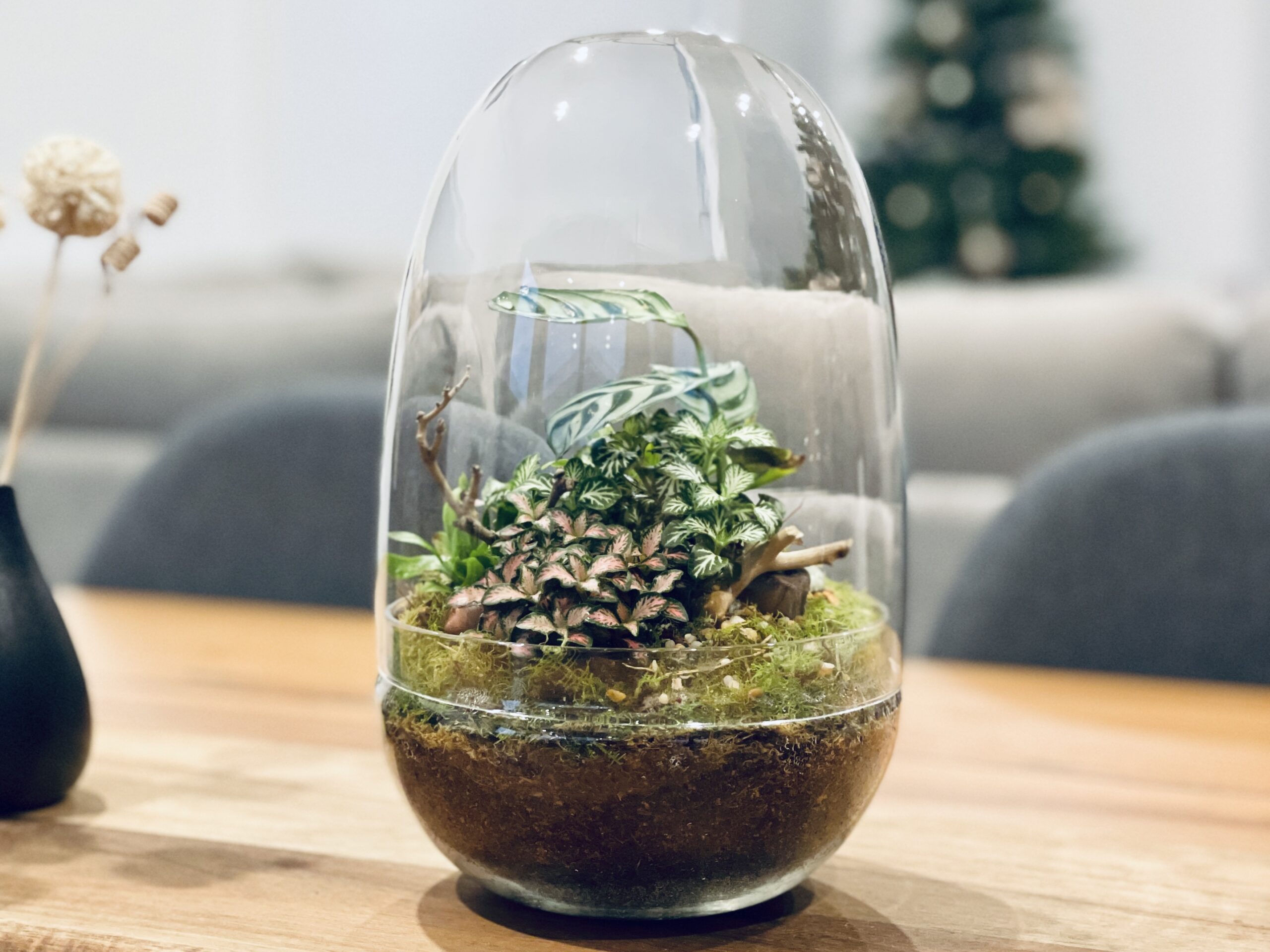Your cart is currently empty!

How to Build Your Own Terrarium: A Beginner’s Guide 🌿
Terrariums are a fun and creative way to bring greenery into your home. In this beginner’s guide, we’ll show you exactly how to build a terrarium from scratch, focusing on a closed terrarium for easy care and maintenance. Whether you’re new to the world of indoor gardens or already have some plant experience, creating your own terrarium is a rewarding and relaxing project. 🎨🌱
What You’ll Need: Your Terrarium Kit 🧰🌿
Before you begin, gather the essential materials for building your terrarium. If you’re wondering how to build a terrarium, these are the supplies you’ll need for success:
Glass Container: Choose any container that suits your style! Glass jars, fish tanks, and vases are popular options. Make sure it has a wide opening for easy access, or you’ll likely need tweezers to help you plant.
Stones or LECA: Rocks, pebbles or LECA (Lightweight Expanded Clay Aggregate) will create drainage at the bottom of the terrarium, preventing water from pooling and causing root rot. Use small to medium-sized stones for the best effect.
Sphagnum Moss or Mesh: This is like a little safety net to keep the soil from mixing with the drainage layer below. Dried sphagnum moss also holds moisture, so it’ll help keep your plants hydrated!
Activated Charcoal: A must-have to prevent odours and mould growth. It helps keep the water and air fresh inside the closed system of your terrarium.
Substrate: Your terrarium soil mix is probably the most important component of your build. While potting mix is a good starting point, a mix of sphagnum moss, coco coir, worm castings and activated charcoal is going to be much better long term. We offer premium terrarium substrate to save you the hassle!
Plants: Choose plants that thrive in a closed environment, such as ferns, moss, and fittonia. Consider your space and container size when selecting your plants.
Decorative Items: Adding pebbles, spider-wood, figurines, shells, or other decorative touches will give your terrarium its own unique style!
Once you have your materials, you’re ready to start building your terrarium!
Step-by-Step Instructions to Build Your Closed Terrarium 🛠️💚
Once you’ve gathered your materials, it’s time to start building your closed terrarium. Knowing how to build a terrariumstep-by-step will make the process enjoyable and simple.
1. Layer the Base: Start by adding a layer of stones or LECA at the bottom of your container. This ensures proper drainage and prevents water from accumulating in the soil. A good rule of thumb is to add about 1-2cm for a small terrarium, or 2-3 cm for a medium to large terrarium. 🌑
2. Barrier Layer: Add some mesh and/or a layer of dried sphagnum moss to to contain the substrate. Soak the sphagnum moss in water and wring it out first. This stops your substrate from falling into the drainage later. 1cm will have it covered.🛡️
3. Add Activated Charcoal: Place a thin layer of activated charcoal above your drainage layer. This acts as a filter, keeping the air inside the terrarium fresh by absorbing any excess moisture or gases. 🌿
4. Soil Layer: Now, add your substrate on top of the charcoal. You’ll want the soil to be about 2-3cm for a small terrarium with small plants, and up to 4-5 cm deep, if you’re building a larger creation. Make sure the soil is evenly spread. This layer is where your plants will grow, so it needs to be deep enough to support their roots. 🌱
5. Planting: Gently place your plants in the soil, arranging them according to size and shape. Larger plants should go in the back (or in the centre for a round terrarium), while smaller ones are better suited for the front. When placing plants, be sure to leave space between them to allow for growth and airflow. If you have live moss, place it in to act as a grass. 🌾
6. Finishing Touches: Add any decorative items to your terrarium to give it a personal touch. You can use small pebbles, spider wood or drift wood, tiny figurines, shells, or even fairy lights to bring a bit of magic to your mini garden. 🌟
7. Watering Your Terrarium: Terrariums are low-maintenance, but they do need some TLC! After planting, give your terrarium a light watering, ideally with a spray bottle. Avoid soaking the soil. In a closed terrarium, the plants will naturally recycle water through evaporation and condensation, so don’t overdo it. Most closed terrariums will only need watering every few months, if at all.💧
8. Find the Perfect Spot: Your terrarium will love bright, indirect sunlight, so find a nice spot by a window with filtered light. Avoid direct sunlight, as it can heat up your terrarium and stress out the plants. Bonus points if you place it under a grow light! ☀️
Tips for Care 🌱💧
Terrariums are easy to care for, but a little attention will help them thrive:
Watering: One of the best things about terrariums is that they’re self-sustaining. However, you may still need to water them occasionally. If the soil feels dry, add a small amount of water. Don’t overwater—too much moisture can cause the plants to rot.
Humidity: A closed terrarium creates its own humidity, which is ideal for tropical plants. If you notice condensation on the glass, that’s a good sign. If it looks dry, mist the plants with a spray bottle to increase humidity. 🌧️
Trimming: Trim overgrown or dead foliage as needed to keep your terrarium neat and healthy. Use clean, sharp scissors to avoid damage and promote new growth. Remove yellowing leaves or dead stems to maintain a fresh, vibrant look.
Ready to Build Your Terrarium?
We hope this guide has helped you get started on your terrarium journey! There’s nothing quite like creating a mini ecosystem that thrives under your care. Ready to build your own? Check out our DIY Terrarium Kits for all the essentials you need to get started! And don’t forget to share your creations with us on Instagram or Facebook—we love seeing your unique designs! Happy gardening! 🌱💚
